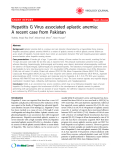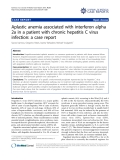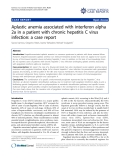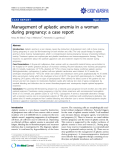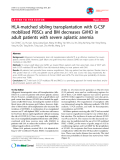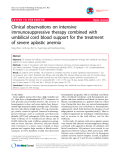
Aplastic anemia
-
Tuyển tập báo cáo các nghiên cứu khoa học quốc tế ngành y học dành cho các bạn tham khảo đề tài: Hepatitis G Virus associated aplastic anemia: A recent case from Pakistan
 3p
3p  dauphong1
dauphong1
 21-12-2011
21-12-2011
 42
42
 4
4
 Download
Download
-
Tham khảo luận văn - đề án 'báo cáo y học: " aplastic anemia associated with interferon alpha 2a in a patient with chronic hepatitis c virus infection: a case report"', luận văn - báo cáo phục vụ nhu cầu học tập, nghiên cứu và làm việc hiệu quả
 5p
5p  thulanh27
thulanh27
 12-12-2011
12-12-2011
 71
71
 5
5
 Download
Download
-
Tuyển tập báo cáo các nghiên cứu khoa học quốc tế ngành y học dành cho các bạn tham khảo đề tài: Aplastic anemia associated with interferon alpha 2a in a patient with chronic hepatitis C virus infection: a case report...
 5p
5p  thulanh26
thulanh26
 09-12-2011
09-12-2011
 39
39
 5
5
 Download
Download
-
Tuyển tập báo cáo các nghiên cứu khoa học quốc tế ngành y học dành cho các bạn tham khảo đề tài: Treatment of stasis dermatitis using aminaphtone: Management of aplastic anemia in a woman during pregnancy: a case report...
 5p
5p  thulanh26
thulanh26
 08-12-2011
08-12-2011
 50
50
 5
5
 Download
Download
-
Tuyển tập báo cáo các nghiên cứu khoa học quốc tế ngành y học dành cho các bạn tham khảo đề tài:HLA-matched sibling transplantation with G-CSF mobilized PBSCs and BM decreases GVHD in adult patients with severe aplastic anemia
 3p
3p  toshiba24
toshiba24
 06-12-2011
06-12-2011
 52
52
 4
4
 Download
Download
-
Tuyển tập báo cáo các nghiên cứu khoa học quốc tế ngành y học dành cho các bạn tham khảo đề tài: Clinical observations on intensive immunosuppressive therapy combined with umbilical cord blood support for the treatment of severe aplastic anemia...
 2p
2p  thulanh25
thulanh25
 06-12-2011
06-12-2011
 57
57
 5
5
 Download
Download
-
Aplastic Anemia Transplantation from matched siblings after a preparative regimen of highdose cyclophosphamide and antithymocyte globulin can cure up to 90% of patients
 5p
5p  thanhongan
thanhongan
 07-12-2010
07-12-2010
 76
76
 3
3
 Download
Download
-
The Transplant Preparative Regimen The treatment regimen administered to patients immediately preceding transplantation is designed to eradicate the patient's underlying disease and, in the setting of allogeneic transplantation, immunosuppress the patient adequately to prevent rejection of the transplanted marrow. The appropriate regimen therefore depends on the disease setting and source of marrow.
 5p
5p  thanhongan
thanhongan
 07-12-2010
07-12-2010
 64
64
 3
3
 Download
Download
-
Pure Red Cell Aplasia: Treatment History, physical examination, and routine laboratory studies may disclose an underlying disease or a suspect drug exposure. Thymoma should be sought by radiographic procedures. Tumor excision is indicated, but anemia does not necessarily improve with surgery. The diagnosis of parvovirus infection requires detection of viral DNA sequences in the blood (IgG and IgM antibodies are commonly absent). The presence of erythroid colonies has been considered predictive of response to immunosuppressive therapy in idiopathic PRCA.
 8p
8p  thanhongan
thanhongan
 07-12-2010
07-12-2010
 57
57
 6
6
 Download
Download
-
Epidemiology Idiopathic MDS is a disease of the elderly; the mean age at onset is 68 years. There is a slight male preponderance. MDS is a relatively common form of bone marrow failure, with reported incidence rates of 35 to 100 per million persons in the general population and 120 to 500 per million in the elderly. MDS is rare in children, but monocytic leukemia can be seen. Therapy-related MDS is not age-related and may occur in as many as 15% of patients within a decade following intensive combined modality treatment for cancer. Rates of MDS have increased over time,...
 5p
5p  thanhongan
thanhongan
 07-12-2010
07-12-2010
 77
77
 6
6
 Download
Download
-
Bone Marrow The bone marrow is usually normal or hypercellular, but in 20% of cases it is sufficiently hypocellular to be confused with aplasia. No single characteristic feature of marrow morphology distinguishes MDS, but the following are commonly observed: dyserythropoietic changes (especially nuclear abnormalities) and ringed sideroblasts in the erythroid lineage; hypogranulation and hyposegmentation in granulocytic precursors, with an increase in myeloblasts; and megakaryocytes showing reduced numbers or disorganized nuclei.
 4p
4p  thanhongan
thanhongan
 07-12-2010
07-12-2010
 79
79
 5
5
 Download
Download
-
Myelodysplasia: Treatment The therapy of MDS has been unsatisfactory. Only stem cell transplantation offers cure: survival rates of 50% at 3 years have been reported, but older patients are particularly prone to develop treatment-related mortality and morbidity. Results of transplant using matched unrelated donors are comparable, although most series contain younger and more highly selected cases.
 8p
8p  thanhongan
thanhongan
 07-12-2010
07-12-2010
 74
74
 5
5
 Download
Download
-
Hematopoietic Stem Cell Transplantation This is the best therapy for the young patient with a fully histocompatible sibling donor (Chap. 108). Human leukocyte antigen (HLA) typing should be ordered as soon as the diagnosis of aplastic anemia is established in a child or younger adult. In transplant candidates, transfusion of blood from family members should be avoided so as to prevent sensitization to histocompatibility antigens; while transfusions in general should be minimized, limited numbers of blood products probably do not seriously affect outcome.
 5p
5p  thanhongan
thanhongan
 07-12-2010
07-12-2010
 65
65
 5
5
 Download
Download
-
Persistent Parvovirus B19 Infection Chronic parvovirus infection is an important, treatable cause of PRCA. This common virus causes a benign exanthem of childhood (fifth disease) and a polyarthralgia/arthritis syndrome in adults. In patients with underlying hemolysis (or any condition that increases demand for red blood cell production), parvovirus infection can cause a transient aplastic crisis and an abrupt but temporary worsening of the anemia due to failed erythropoiesis.
 5p
5p  thanhongan
thanhongan
 07-12-2010
07-12-2010
 61
61
 5
5
 Download
Download
-
Outcomes following both transplant and immunosuppression have improved with time. High doses of cyclophosphamide, without stem cell rescue, have been reported to produce durable hematologic recovery, without relapse or evolution to MDS, but this treatment can produce sustained severe fatal neutropenia and response is often delayed. New immunosuppressive drugs in clinical trial may further improve outcome.
 5p
5p  thanhongan
thanhongan
 07-12-2010
07-12-2010
 68
68
 4
4
 Download
Download
-
Definition and Differential Diagnosis PRCA is characterized by anemia, reticulocytopenia, and absent or rare erythroid precursor cells in the bone marrow. The classification of PRCA is shown in Table 102-4. In adults, PRCA is acquired. An identical syndrome can occur constitutionally: Diamond-Blackfan anemia, or congenital PRCA, is diagnosed at birth or in early childhood and often responds to glucocorticoid treatment; a minority of patients have etiologic mutations in a ribosomal RNA processing gene called RPS19.
 5p
5p  thanhongan
thanhongan
 07-12-2010
07-12-2010
 76
76
 4
4
 Download
Download
-
Pathophysiology Bone marrow failure results from severe damage to the hematopoietic cell compartment. In aplastic anemia, replacement of the bone marrow by fat is apparent in the morphology of the biopsy specimen (Fig. 102-1) and MRI of the spine. Cells bearing the CD34 antigen, a marker of early hematopoietic cells, are greatly diminished, and in functional studies, committed and primitive progenitor cells are virtually absent; in vitro assays have suggested that the stem cell pool is reduced to ≤1% of normal in severe disease at the time of presentation. Figure 102-1 A.
 5p
5p  thanhongan
thanhongan
 07-12-2010
07-12-2010
 73
73
 6
6
 Download
Download
-
Immune-Mediated Injury The recovery of marrow function in some patients prepared for bone marrow transplantation with antilymphocyte globulin (ALG) first suggested that aplastic anemia might be immune-mediated. Consistent with this hypothesis was the frequent failure of simple bone marrow transplantation from a syngeneic twin, without conditioning cytotoxic chemotherapy, which also argued both against simple stem cell absence as the cause and for the presence of a host factor producing marrow failure. Laboratory data support an important role for the immune system in aplastic anemia.
 5p
5p  thanhongan
thanhongan
 07-12-2010
07-12-2010
 80
80
 5
5
 Download
Download
-
Bone Marrow The bone marrow is usually readily aspirated but dilute on smear, and the fatty biopsy specimen may be grossly pale on withdrawal; a "dry tap" instead suggests fibrosis or myelophthisis.
 5p
5p  thanhongan
thanhongan
 07-12-2010
07-12-2010
 75
75
 5
5
 Download
Download
-
Harrison's Internal Medicine Chapter 102. Aplastic Anemia, Myelodysplasia, and Related Bone Marrow Failure Syndromes Aplastic Anemia, Myelodysplasia, and Related Bone Marrow Failure Syndromes: Introduction The hypoproliferative anemias are normochromic, normocytic or macrocytic and are characterized by a low reticulocyte count. Deficient production of RBCs occurs with marrow damage and dysfunction, which may be secondary to infection, inflammation, and cancer.
 5p
5p  thanhongan
thanhongan
 07-12-2010
07-12-2010
 75
75
 5
5
 Download
Download
CHỦ ĐỀ BẠN MUỐN TÌM








